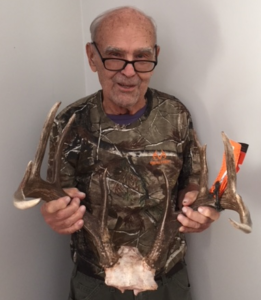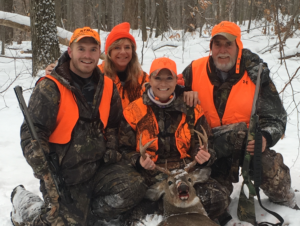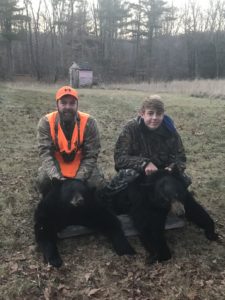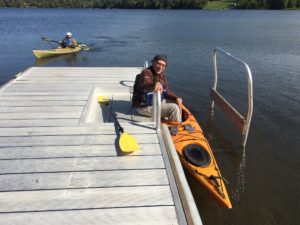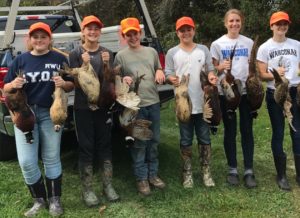Many outdoor enthusiasts are taking to the ice now that we are in mid winter. There are several ice fishing derbies taking place this and the next few weekends. Due to the warmth, last year’s season ended early and many ice fishermen felt short-changed. They were stuck with a lot of deer meat that they had intended to cook out on the ice.
This year has been another funny one with hard freeze – rain and thaw – hard freeze – rain, etc. The last forecast that I saw for this weekend was rain. Listed are some of the ice fishing derbies scheduled to take place in February, but as the dates near, perhaps you should check with the derby organizers just to be sure that none of them were cancelled due to ice conditions.
Upcoming Derbies
The Ashfield Rod & Gun Club’s Annual Youth Ice Fishing Derby will take place on Saturday, February 10 from 8 AM to 12 PM. New this year, there will be a 3 tip-up/hook limit due to the lake drawdown. Prizes will be awarded for all legally caught fish checked in at headquarters (The Ashfield Lake House). After the derby, a spaghetti dinner will be held at Sanderson Academy. There will be a $5 charge for adults, free for kids. Following the dinner, MassWildlife Western District Biologist Nathan Buckhout will be giving a presentation at the academy. For additional derby information, contact Joe Miraglia at (413) 628-4400.
The 32nd annual Jimmy Fund Ice Fishing Derby will take place on Onota Lake on Sunday, February 11. This derby is in memory of Bill “Geli” Gelinas, John Porter, Chris Porter, Cathy Saldo and John Drury. It will run from 6 AM to 2 PM. Tickets cost $15 for adults and $5 for kids and they are available in advance at the Onota Boat Livery on Pecks Road (413) 443-1366, and Maces Marine on Valentine Road, Pittsfield (413) 447-7512 or on the day of the derby at the Frank Controy Pavilion at Burbank Park on Onota Lake. Three divisions of trophies and prizes and plenty of good food.
The Lee Sportsmen’s Association will be holding its Ice Fishing Derby also on February 11 from 6 AM to 2 PM on Goose Pond. Check/weigh in will be at the shanty. Cost is $10 for adults and $6 for kids 12 and under. The adult winner of the heaviest fish will receive $100, and kids will win various prizes. There will be a spaghetti dinner at the LSA clubhouse afterwards. For more information, contact John Polastry at (413)822-8278.
On February 18, the Cheshire Rod & Gun Club will be holding its annual ice fishing derby on the 1st and 2nd Hoosac Lakes (Cheshire Lake) from sunrise to 4 PM. Weigh in will be at Farnams Causeway. An Eskimo Propane Auger ($500 value) will be awarded to the heaviest ticket holder fish. There will be youth fun prizes for 1st, 2nd and 3rd places. Prizes and refreshments at 5 PM at the Club House. Kids 14 and under free with adult ticket. For more information, contact Corey McGrath at (413)841-5070.
If ice fishing derbies don’t appeal to you, perhaps you would prefer doing a family ice fishing day such as that held by the Kinneys of Dalton. As my wife Jan and I approached them on Ashmere Lake in Hinsdale last Sunday, we were delighted to see kids were having fun playing out on the ice and catching fish. It was nice seeing kids outdoors and not sitting home playing computer games. Grandpa and the dads set up along an undeveloped shoreline, something becoming more and more rare these days. In the old days, there was no problem finding such places, but now much of our lake shorelines are developed and have “No Trespassing” signs.
As we neared, we could hear the crackling sound and smell of burning wood from a small bonfire that was made with wood that they brought with them in their sled and dead wood and sticks found on the nearby forest floor. No saws were seen there, nor propane tanks nor hibachis on which to cook their food. Just like the old days, the food was simple and easy to prepare……hot dogs on a wooden spit over the open fire. I suspect that gramps Lawrence “Chip” Kinney had something to do with that, for surely, he remembers those old ice fishing days, too.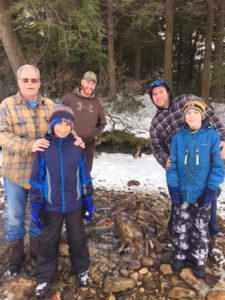
Boy! Did that bring back memories. After gabbing with them for a while, and admiring pictures of the nice fish that the kids had caught and released, Jan and I (and Jacques our beagle) left them. But that sight and memories still lingered in my mind and after some urging from Jan, I went back to take their picture and get their names.
If you closely observe the picture, you will see the bonfire with pieces of old logs and branches burning away. Now I ask you old timers, does that bring back fond memories?
Fundraiser for pheasants
There will be a turkey shoot at the Lee Sportsmen’s Association today starting at 1:00 PM and following that there will be a venison stew and spaghetti dinner at the Club. The cost is $15 for adults and $7 for kids under 12 years old. The proceeds of these events will be used to raise pheasants to be stocked on lands for the general public to hunt. Contact John Polastri for more information.
Incidentally, the LSA is the only Berkshire County sportsmen’s club that raises and stocks pheasants and only one of two clubs in Western Mass that does so.
Basic Hunter Education Course
There will be a basic hunter education course held at the Pittsfield High School, 300 East Street, Pittsfield, Massachusetts on: March 6, 8, 13, 15, 20 and 22 (all Tuesday and Thursday evenings), from 6:00 to 9:00 PM. You must attend all class dates and times to successfully complete the course. If you are interested in this course and wish to enroll, call (508) 389-7830 immediately; students are enrolled first-come, first-served, and courses fill quickly.
Fly Tying
Henry Sweren, president of the Taconic Chapter of Trout Unlimited, recently announced that free Winter Fly Tying Sunday Afternoon events will be held at Berkshire Hills Country Club from Noon to 3 PM on February 11, 18 and March 4h and 18. For more information, contact Henry at (413) 822-5216.
Regulations Prohibiting Bump Stocks and Trigger Cranks
If you hold a Massachusetts firearms license or firearms identification card, you should have or will be receiving a notice from the Commonwealth of Massachusetts Executive Office of Public Safety and Security. Section 52 of Chapter 110 of the Acts of 2017 directs them to inform you that bump stocks and trigger cranks are illegal in Massachusetts. Section 53 of Chapter 110 provides the changes that will take effect in two stages: Effective immediately upon its signing, the new law prohibited the purchase, sale or offering for sale of trigger cranks or bump stocks. Effective February 1, 2018, the new law will prohibit possession of bump stocks or trigger cranks, including possession in a private home. There are no exceptions to this prohibition for licensed firearm owners; an FID card, a License to Carry or even a license to possess a machine gun will not authorize possession of a bump stock or trigger crank.
Because the law does not allow for transfer or sale of these prohibited items, if you currently possess one of them within Massachusetts, you should contact your local police department or Massachusetts State Police to get details about how to transfer custody of the prohibited item to the police for destruction. Retention of such a prohibited item beyond the 90-day period will expose the owner to criminal prosecution.
I think most gun owners know why this new regulation came about (Las Vegas shooting) and should have been expecting it.
If you did not receive this notice, you may have a problem on your hands. If you have moved, Massachusetts General Law Chapter 140, section 131(l) states: Any licensee shall notify, in writing, the licensing authority who issued such license, the chief of police into whose jurisdiction the licensee moves and the executive director of the criminal history systems board of any change of address. Such notification shall be made by certified mail within 30 days of its occurrence. Failure to so notify shall be cause for revocation or suspension of said license.
Good luck!

